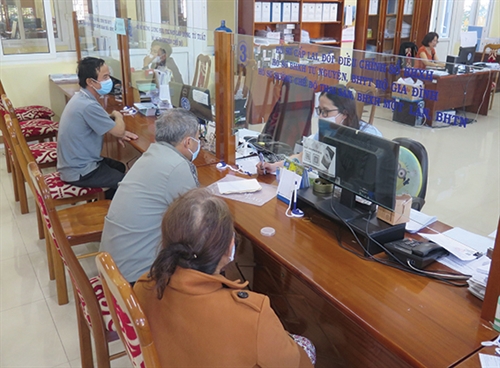There have been times when the gap between domestic and global gold prices mounted to over VND 20 million per tael. It’s not to mention the difference in price between the Saigon Jewelry Company Limited (SJC)’s gold bullions and gold of other brands. Has the State Bank conducted any inspection of the price volatility? Whether or not there is a handshake aiming at manipulating the price of SJC gold bars and when will the central bank propose the Government to amend Decree 24 of 2012 on gold business activities so as to substantially address the issues arising in the gold market over the past time?
These above questions were put by National Assembly deputy Nguyen Phuong Thuy to State Bank Governor Nguyen Thi Hong at a “question-and-answer” session during the 15th National Assembly’s third sitting last month.
 |
The issue of gold price was raised amid wild fluctuations in the domestic gold market over the past few months. On March 8, the selling price of gold bars produced by the SJC set a record at approximately VND 74 million per tael, an increase of as much as VND 5 million compared to the price at the immediately preceding trading session. Most recently on July 18, the selling price of SJC gold bars sharply dropped by roughly VND 5.5 million to VND 63 million per tael in just one day, shocking the whole market.
Obviously, the fluctuation of the gold price in Vietnam depends on developments in the international market. The abnormality here lies in the gold price gap between Vietnam and the world. On the trading session of March 8, when the gold price in the global market increased by just VND 840,000 per tael, the price of SJC gold bars was pushed up by nearly VND 5 million per tael, roughly six times the world’s variation without any reason.
According to Duong Anh Vu, a gold industry expert, the prolonged disparity in the gold price between Vietnam and the international market will cause damage to the economy in general and the gold market in particular. “For the economy, a high difference in the gold price [between Vietnam and the world market] will lead to gold smuggling, affecting foreign exchange rates in the “black” market and causing “drain” of foreign currency,” he said.
“Earlier this year, when the difference in the gold price in Vietnam and the world was VND 12 million per tael, the Vietnam dong to US dollar exchange rate on the unofficial market was 23,480 VND/USD, and when the difference reached VND 18 million per tael, the exchange rate sharply increased to nearly 24,000 VND/USD,” the expert analyzed.
The difference in the price of SJC gold bars and those of other jewelers’ gold products of the same gold content is another issue. Also on March 8, while the price of SJC gold bars hit a record high of nearly VND 74,000 per tael, jewelry gold and material gold were sold at VND 57 million per tael, a terribly unreasonable disparity of VND 17 million per tael.
Reasons behind the odd situation in the gold market
For the time being in Vietnam, the State holds a monopoly in production of gold bars. According to Decree 24/2012/ND-CP on gold business activities, which came into force on May 25, 2012, the State, via the State Bank, exercises the monopoly in production of gold bars, export of material gold and import of material gold for production of gold bars. In furtherance of Decree 24, the central bank decided to outsource the production of gold bars to SJC, the company that held more than 90 percent of the gold bar market at that time.
The issuance of Decree 24 has brought about many positive affects to the economy. The gold price no longer impacted the prices of other essential goods, especially foreign exchange rates, thus helping maintain macroeconomic stability. However, during 10 years since the enactment of the Decree, the economy in general and the gold market in particular have changed a lot. In 2012, the gold price in Vietnam was around VND 30-35 million per tael. Ten years later, it has doubled to VND 60-70 million per tael. More importantly, the gap in gold price between Vietnam and the world, which was just around VND 1.5 million per tael when Decree 24 was issued, has incrementally increased until reaching the recent peak of VND 20 million per tael.
Huynh Trung Khanh, senior advisor of the World Gold Council (WGC) in Singapore, Thailand, Indonesia and Vietnam, analyzed that the difference in the price of SJC gold bars and those of other gold producers appeared two years after the issuance of Decree 24 when Vietnam stopped the import of material gold. In other words, the supply of gold bars to the market was almost cut off. Especially since 2014, the State Bank no longer produces SJC gold bars but only re-stamps deformed gold bars.
“Therefore, the supply of SJC gold bars in the market in the past eight years has not increased but incrementally decreased, while the demand for this type of gold is always existent thanks to its high liquidity and easy tally. When demand exceeds supply, the price of SJC gold has the opportunity to rise sharply,” Khanh was quoted by plo.vn as saying.
The expert went on to point out that in many countries where domestic markets are connected to the world market, the difference in gold prices at home and abroad is only a few US dollars per ounce. For example, the gap in the gold price between Singapore and the world is about USD 5-6 per ounce, equivalent to around VND 170,000 VND per tael.
“The Singaporean gold market is an open, integrated, and globally connected market, so the gold price gap is kept at a reasonable level. As for a closed gold market like Vietnam’s, the difference is unpredictable. For whatever goods items the State bans from import, once the supply is scarce and the demand still exists, the price will increase until supply meets demand. That’s one of the economic laws,” Khanh emphasized.
Hoang Nghia, a professional gold investor in Ho Chi Minh City, commented: “There were times when speculation appeared in the gold market amid scarcity of SJC gold bars. In particular, some “big players” push the gold price up to a very high level when they found the supply is not enough or enlarge the difference between the buying and selling prices to pass the risk to consumers.”
Decree 24 under scrutiny
Is it the time for the State Bank to take action to rectify the domestic gold market to make it compatible with the world market? After 10 years of implementation, has Decree 24 revealed any shortcomings and when will it be revised?
State Bank Governor Nguyen Thi Hong, in response to questions of National Assembly deputy Nguyen Phuong Thuy, said the State Bank will review and evaluate the implementation of Decree 24 in the time to come, focusing on the issue of monopoly in gold bar production. The Governor revealed that the State Bank will also carefully consider the possibility of permitting the import of gold to cool down the market when necessary.
Concluding the “question-and-answer” session for Governor Hong, National Assembly Chairman Vuong Dinh Hue asked for reviewing and amending relevant legal documents, including Decree 24, in order to improve the legal framework regulating monetary, foreign exchange management, gold business, and banking operations.-









